
furniture
- Movable or stationery (sometimes "built-in"), and often larger articles that make a room or other place fit for
living or working. Examples include tables, chairs, desks, shelving
units, chests of drawers, and beds.
Furniture is designed for two principal qualities: aesthetic and functional. It must provide comfort at a human scale, while employing materials (including wood, metals, textiles [upholstery], plastics, etc.) with pleasing uses of the elements and principles of design. Furniture is typically expected to have significant strength (structure) and durability.
Styles of furniture have often paralleled those of other categories of art and design, but some stand apart from styles found in the other arts. Some furniture styles include Renaissance, Baroque, Louis XIV, Louis XV, Louis XVI, empire, Biedermeier, Arts and Crafts Movement, Art Nouveau, Art Deco, and modern. Styles of furniture are also characterized as being of the various nations.
There is a theory that many furniture designs evolved from that of the chest (box).
Examples of furniture:

Egypt, Chair of Renyseneb, c. 1450 BCE,
mid-Dynasty 18, New Kingdom, ebony, ivory, height
35 inches (86.2 cm), Metropolitan Museum of Art, NY. See Egyptian art.

Egypt, c. 1400-1300 BCE,
18th Dynasty, Chair, wood,
inlaid with ivory (or bone); the leather strips are modern,
91 x 47.5 x 59 cm, Louvre. Note similarities to the previous example.

Assyria, Throne with Inscription, 1243-1207 BCE,
alabaster, width 57 cm, Near-Eastern Museum,
Berlin.

France, Dresser, second half of the 15th century,
oak, carved, painted
and gilt, copper,
iron, 266 x 137
x 53.5 cm, Hermitage Museum, St. Petersburg, Russia.
Italy, Rome, Chest (Cassone), second half of the 16th century, walnut, carved and gilt, 186 x 68 x 57 cm, Hermitage Museum, St. Petersburg, Russia. During the Renaissance a special place was occupied in Italian households by cassone — chests — in which brides' dowries were stored. They were usually made in pairs to stand next to each other in a room. See Renaissance.
Italy, third quarter of the 16th century, Pair of Cassoni with Reliefs of Apollo, carved walnut, height 28 1/8 inches (71.4 cm), width 66 3/4 inches (169.5 cm), diameter 22 3/8 inches (56.9 cm), Frick Collection, NY.
![]()

![]()
France, 1617, Armoire, walnut, 2.55 x 1.78 x .75 m, Louvre.

America, Eastern Massachusetts, Armchair or "great chair",
1640-1680, ash, 44 3/4 x 23 1/2 x 15 3/4 inches (113.7 x 59.7
x 40.0 cm), Metropolitan Museum of Art, NY.

France, c. 1645, Cabinet, Paris, oak and poplar, ebony
veneering, blackened fruit-tree wood, 1.85 x 1.58 x .56 m, Louvre.

William Searle (American, 1634-1667, Ipswich,
Massachusetts) and/or Thomas Dennis (American, 1638-1706), Chest, 1660-1680, red oak, white oak,
29 3/4 x 49 1/8 x 21 3/8 inches (75.6 x 124.8 x 54.3 cm), Metropolitan
Museum of Art, NY.
André-Charles Boulle (French, 1642-1732) (workshop of), Kneehole desk with tendril marquetry of tortoiseshell and brass, c.1700, carcass of oak and fir, drawers of walnut and oak; veneered with panels of brass inlaid with tortoiseshell marquetry and bordered by ebony; mounts of gilt bronze; top covered with black leather, height 30 3/4 inches (78.1 cm), width 57 7/8 inches (147 cm), diameter 29 1/8 inches (74 cm), Frick Collection, NY. See Baroque.

André-Charles Boulle, Wardrobe (alternatively known as an Armoire), Paris, around 1700, made of oak and pine, with
ebony, tortoiseshell, inlaid (marquetry)
with brass and tin
veneering, pewter,
horn, and gilded
bronze (ormolu),
102 x 58 x 25 inches (260 x 148 x 64 cm), Louvre.

France, beginning of the 18th century, Table with Nine Feet, gilded oak, marble, 0.88 x 1.85 x .75 m, Louvre.

Attributed to Nicolas Foliot, Fauteuil, mid-18th century, France, wood,
carved and gilt,
upholstered in red velvet,
silver embroidery,
113 x 77 x 90 cm, Hermitage Museum, St. Petersburg, Russia. Made
for Louis XV's daughter, the Princess of Parma, for her Italian
palace, this chair retains the original
upholstery, which includes embroidery on the back and seat.

Caleb Gardner (American, Newport, RI), Easy Chair, 1758, walnut, maple, 46 3/8
x 32 3/8 x 25 7/8 inches (117.8 x 82.2 x 65.7 cm), Metropolitan
Museum of Art, NY.

Jacques Dubois (French, c. 1693-1763), Desk from the Château du Raincy, Paris,
mid-18th century, oak, pine and fruit-tree wood, black lacquer,
gilt bronze,
leather, 0.82
x 1.86 x 1 m, Louvre.

Jean-François Leleu (French, 1729-1807),
Commode Belonging to the Prince de Condé,
Paris, 1772, oak, purple-wood panelling, marquetry,
gilt bronze,
red-veined marble, 0.88 x 1.17
m, Louvre.

Georges Jacob (French, 1739-1814), Armchair from the Turkish Room of the Comic d'Artois
at the Temple, Paris, 1777, gilt
walnut, 0.94 x 0.70 m, Louvre.

Adam Weisweiler (French, 1744-1784), Writing Table Belonging to Queen Marie-Antoinette,
Paris, 1784, oak, ebony veneering,
lacquer, mother-of-pearl,
steel, gilt
bronze, 0.82 x 0.47 m, Louvre.

Duncan Phyfe (American, 1768-1854, New York,
NY), Sofa, 1810-1820, mahogany, tulip poplar,
cane, gilt brass,
34 x 84 3/4 x 23 3/4 inches (86.4 x 215.3 x 60.3 cm), Metropolitan
Museum of Art, NY.

François-Honoré-Georges Jacob-Desmalter
(French, 1770-1841), Jewel Cabinet Belonging to the Empress Josephine,
Paris, 1809, oak, yew and purple-wood veneering,
mother-of-pearl, gilt bronze,
2.75 x 2.00 m, Louvre.

George Jakob Hunzinger (American, 1835-1898,
New York, NY), Settee, c. 1876-1885, ebonized cherry,
fabric-covered steel
mesh, 39 5/8 x 67 3/8 x 22 5/8 inches (100.6 x 171.1 x 57.5 cm),
Metropolitan Museum of Art, NY.

Christian Herter, designer (American, born
Germany, 1840-1883, Herter Brothers, maker, New York, active
c. 1860 - c. 1905, Side Chair, c. 1882, gilded
maple, mother-of-pearl
inlay, and replacement
embroidered silk upholstery,
Carnegie Museum of Art, Pittsburgh, PA. See wood.

Herter Brothers, Library table, 1882, rosewood, brass,
mother-of-pearl, 31 1/4
x 60 x 35 3/4 inches (79.4 x 152.4 x 90.8 cm), Metropolitan Museum
of Art, NY.

Carlo Bugatti (Italian, 1855 or 56-1940),
Cobra
Chair, 1902, vellum,
wood, copper,
crayon, and paint,
Carnegie Museum of Art, Pittsburgh, PA.

Carlo Bugatti, Bugatti Table: wood (mahogany?), cast and gilded
metal mounts, inlays
of ivory or bone,
metal, and mother-of-pearl,
height 71.1 cm, c. 1910,
Tea and Coffee Service: Carlo Bugatti
designer, executed by A.A. Hebrard, silver and ivory, c. 1907, Cleveland Museum of Art.

Josef Hoffmann (Austrian, 1870-1956), designer, at
the studio of Wiener Werkstätte, for J. & J. Kohn, Austrian manufacturer, Sitzmaschine Chair with Adjustable Back,
c. 1905, bent beechwood and sycamore panels, 43 1/2 x 28 1/4
x 32 inches (110.5 x 71.8 x 81.3 cm), Museum of Modern Art, NY. "Sitzmashine" is literally "machine for sitting," an apparent bow to the mechanical aspects of the modernism. Hoffmann and the Wiener Werkstätte championed the aesthetic of the Vienna Secession.

Charles Rennie Mackintosh (Scottish, 1868-1928),
designer, Washstand, 1904, oak, ceramic
tile, leaded colored glass and mirror
glass, 63 1/4 x 51 1/4 x 20 3/8 inches (160.7 x 130.2 x 51.8
cm), Metropolitan Museum of Art, NY. See Arts
and Crafts Movement and Scottish
art.

Charles Rennie Mackintosh, Hill House Chair, 1904, black lacquered
wood with upholstered
seat, 55 x 16 x 14 1/4 inches.

Josef Hoffmann (Austrian, 1870-1956) and
Wiener Werkstätte, Table, 1903-1904, solid oak wood
and oak wood veneer,
black satin, white paint, polished
boxwood inlay, white metal, 30 x 24 3/4 x 24 3/4
inches, Minneapolis Institute of Arts.
Walter Gropius (German, 1883-1969). See Bauhaus.

Gerrit T. Rietveld (Dutch, 1884-1964), Red-Blue
Chair, c. 1923, hardwood lacquered in blue, red, and yellow. Although this chair's design is consistent with the aesthetic of De Stijl, it was presented at a Bauhaus exhibition in 1923.

Gerrit Rietveld, Zig Zag Chair, 1934, hardwood.

Ludwig Mies van der Rohe (German-American,
1886-1969), designer, "MR" Armchair, 1927, chrome-plated steel and painted
caning, 31 1/2 x 22 x 37 inches (80 x 55.9 x 94 cm), Metropolitan
Museum of Art, NY. This was developed from a 1924 design for
a cantilevered chair by
Mart Stam. It was introduced by Mies van der Rohe at the 1927
Stuttgart exhibition and has remained in production ever since.
Mies van der Rohe was the last director of the Bauhaus design school in Dessau, from 1930
until its closing in 1932.
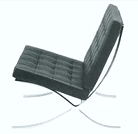
Ludwig Mies van der Rohe, Barcelona Chair,
1929, chrome-plated
steel and black
leather.

Alvar Aalto (Finnish, 1898-1976), Armchair (Chair 31), c. 1930, birch-faced
plywood, laminated birch, 26 15/16 x 24 1/16 x 30 1/2 inches,
Minneapolis Institute of Arts.

Marcel Breuer (German, 1902-1981), Wassily
Chair, 1925, chrome-plated steel and black leather.
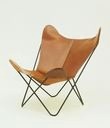
Antonio Bonet, Juan Kurchan and Jorge Ferrari Hardoy, manufactured by Artek-Pascoe, Inc., New York, NY, B.K.F. Chair, 1938, painted wrought-iron rod and leather, 34 3/8 x 32 3/4 x 29 3/4 inches (87.3 x 83.2 x 75.6 cm).

Isamu Noguchi (American, 1904-1988), Coffee Table, 1954, base: solid black lacquered ash; top: 15 mm glass; entire: 45 x 128 x 92 cm.

Charles Eames (American, 1907-1978), Shell
Chair, 1946, polyester,
metal frame, Kunstgewerbemuseum, Berlin. Charles
and his wife Ray were pioneers in the use of molded
plywood in designing chairs whose back and seat pieces were shaped
to the contours of the human body.

Charles Eames and Ray Eames, manufactured by Herman Miller Furniture Co., Zeeland, MI, Lounge Chair and Ottoman, 1956, molded rosewood, plywood, leather, cast aluminum, rubber shock mounts, and stainless steel glides, chair: 33 x 33 3/4 x 33 inches (83.8 x 85.7 x 83.8 cm), ottoman: 16 x 26 x 21 inches (40.6 x 66 x 53.3 cm), Museum of Modern
Art, NY.
Eero Saarinen (Finnish-American, 1910-1961)
Ettore Sottsass (Italian, 1917-)

Joe Colombo (Italian, 1930-1971), designer; manufactured by Flexform,
Italy, Tube Chair of Nesting and Combinable Elements,
1955, PVC plastic
tubes, chrome plated
steel rod,
natural rubber and polyurethane foam with synthetic
textile
show cover, nested: 25 1/2 x 19 3/8 inches (64.8 x 49.2 cm) diameter, Museum of Modern
Art, NY.
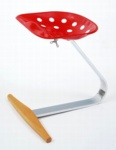
Achille Castiglioni and Pier Giacomo Castiglioni, manufactured by Zanotta S.p.A., Italy, Mezzadro Seat, 1957, tractor seat, steel, and beech, 20 1/4 x 19 1/2 x 20 1/4 inches (51.4 x 49.5 x 51.4 cm), Museum of Modern Art, NY.

Verner Panton (German, 1926-1998), manufactured by Vitra-Fehlbaum
GmbH, Weil-am-Rhein, Germany, Panton Stacking Side Chair, 1959-60,
rigid polyurethane foam with lacquer
finish, 32 5/8 x 19 1/4
x 23 1/2 inches (82.9 x 48.9 x 59.7 cm), Museum of Modern Art,
NY. See plastic.
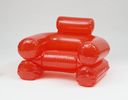
Paolo Lomazzi, Donato D'Urbino and Jonathan De Pas, manufactured by Zanotta S.p.A., Italy, Blow Inflatable Armchair, 1967, polyvinyl chloride (PVC) plastic, inflated: 33 x 47 1/8 x 40 1/4 inches (83.8 x 119.7 x 102.9 cm), Museum of Modern Art, NY. See inflatable.
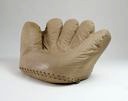
Paolo Lomazzi, Donato D'Urbino and Jonathan De Pas, manufactured by Poltronova, Italy, Joe Sofa, 1968, polyurethane foam and leather, 33 1/2 x 65 1/4 x 41 3/4 inches (85.1 x 165.7 x 106 cm), Museum of Modern Art, NY.
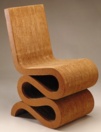
Frank O. Gehry (American, born Canada, 1929-), designer, Easy Edges, c. 1972, side chair, corrugated
cardboard,
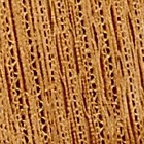 33 x 14 1/2 x 23 inches, Minneapolis Institute
of Arts.
33 x 14 1/2 x 23 inches, Minneapolis Institute
of Arts.
A detail of this chair's back reveals the textural qualities produced by the laminated sheets of corrugated cardboard of which Easy Edges is constructed. See architect.

Frank O. Gehry, manufacturer: New City Editions,
USA, Bubbles Chaise Longue, 1987, corrugated
cardboard with fire-retardant coating, 35 inches x 28 1/2
inches x 6 feet 1 inches (88.9 x 72.4 x 185.4 cm), Museum of
Modern Art, NY.

Frank O. Gehry, Knoll International, Inc.,
Cross Check armchair, 1989, maple laminate, Columbia Museum
of Art, SC.

Allen Jones (English, 1937-), Chair, 1969, painted plastic and mixed media, 77.5 x 57.1 x 99.1 cm, Tate Gallery, London.

![]()

Tom Dixon (contemporary), manufactured by Cappellini S.p.A., Arosio, Italy, S Chair, 1991, rush and steel, 40 3/8 x 19 1/4 x 22 7/8 inches (102.6 x 48.9 x 58.1 cm), Museum of Modern Art, NY.

![]()

Donald T. Chadwick and William Stumpf (Americans, contemporary), manufactured by Herman Miller, Inc., Zeeland, MI, Aeron Office Chair, 1992, structure: glass-reinforced polyester and die-cast aluminum; pellicle: Hytrel polymer, polyester, and Lycra; dimensions range from a minimum height of 37 1/4 inches (94.6 cm) to a max height of 43 inches (109.2 cm) x 28 1/2 x 28 1/2 inches (72.4 x 72.4 cm), Museum of Modern Art, NY.

Tokujin Yoshioka (Japanese, contemporary), manufactured by Tokujin Yoshioka, Honey-Pop Armchair, 2000, paper, .1 unfolded: 31 1/4 x 32 x 32 inches (79.4 x 81.3 x 81.3 cm) .2 folded: 31 1/4 x 36 1/2 x 3/4 inches (79.4 x 92.7 x 1.9 cm), Museum of Modern Art, NY.

Todd Falkowsky (Canadian?, contemporary product designer), Toy Chair, 2003, mixed media, including many plush dolls. This design by Falkowsky was made at the same time that 21 chairs of various shapes, sizes, materials, and purposes were designed and produced by Kathleen Schratz’s grade three students at Ryerson Community Public School in Toronto, Canada. Schratz partnered with Todd Falkowsky to create a design awareness program that enabled the childhood ability to engage in creative design activities. Look at their page about the project.
Also see applied arts,
architecture, basketry,
design, drapery, easel, egg-and-dart,
Index of American Design, mantel,
raffia, screen, stain,
vernacular, and vitrine.
https://inform.quest/_art
Copyright © 1996-![]()